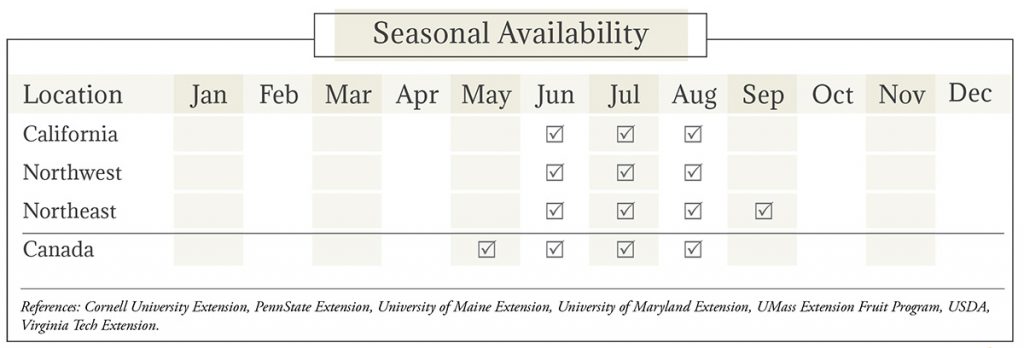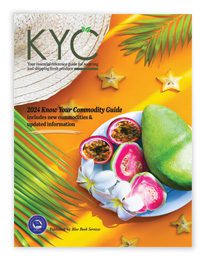Currant and Gooseberry Market Summary


Images: OlgaBartashevich, VetalStock/Shutterstock.com
Currant and Gooseberry Market Overview
Currants and gooseberries are woody, flowering, perennial shrubs with both ornamental and nutritional value. The two species—close relatives within the genus Ribes—can be differentiated by the presence of thorns: gooseberries have thorns and currants do not. Some people confuse the term “currant” as meaning dried grapes that resemble raisins (often called Zante currants or Corinth raisins), but the currants in this profile are soft berry-like fruits. In the nineteenth century, gooseberry “clubs” were popular in Europe, with enthusiasts vying to produce the best crops. The trend expanded to the northeastern United States until 1912, when the federal government banned the cultivation of currants and gooseberries because both species served as hosts for white pine blister rust, a disease that jeopardized the U.S. lumber industry. Although the government repealed the federal prohibition in 1966, individual states still maintain varying restrictions on cultivation. Consequently, commercial production remains minimal in North America. Interestingly, Cornell University estimates less than 0.1% of Americans have ever even sampled a black currant. Russia, Germany, and Poland lead the world in currant and gooseberry production. North American production is concentrated in the northeast and northwest of both the United States and Canada. Currants and gooseberries boast high levels of Vitamin C and are credited with immunity-boosting and anti-inflammatory properties. They are both commonly used in juices, jams, and jellies, as well as desserts like pies, tarts, and cobblers.
Types & Varieties of Currants and Gooseberries
The Ribes species encompasses a diverse array of varieties with differences in shape, texture, coloration, plant size, form, and flavor (sweet and sour). Currants are generally classified as red, pink, black (deep purple), and white, although the latter’s availability is significantly limited. Red currants range from dark red to pink and sometimes exhibit yellow, white, and beige coloration. Even after achieving full color, red currants continue sweetening on the bush. Red Lake, Rovada, and Wilder are a few red varieties. Blanka is a white currant cultivar. Common cultivars of black currants include Consort, Crusader, Coronet, and Titania—all of which are resistant or immune to white pine blister rust. Gooseberries come in both American and European varieties in colors ranging from green, yellow, red, pink, and purple/black. They usually have a more tart flavor than currants, similar to rhubarb. Darker berries are sweeter. Although European gooseberries are generally larger and more flavorful, they are more vulnerable to disease. The best American gooseberry cultivars are Pixwell, Downing, and Poorman. Jostaberries are an interspecies hybrid combining black currants and gooseberries. Cultivars include Jostaberry and the recently released Orus 8.

Cultivation of Currants and Gooseberries
Currants and gooseberries prefer full sunlight but can tolerate partial shade and, unlike many fruit crops, thrive in cool and moist conditions. They are also extraordinarily resilient, capable of growing at elevations of up to 10,000 feet. Windbreaks can prevent drying winds from stunting plant and fruit development. Soil should be rich, loamy, and well-drained, with an approximate pH of 6.5—incorporating additional organic matter such as compost and clearing perennial weed plants are crucial to effective cultivation. Sites should be prepared in the fall. In fall or early spring, well-rooted dormant plants (1- to 2-years-old) are used for propagation. The timing is important to ensure root growth before summer weather arrives. Additionally, the winter does not threaten plant maturation: currant and gooseberry plants—even those developing leaves—can withstand temperatures as low as 19°F. Pruning in late winter or early spring prior to bud swelling is essential to healthy cultivation of both currants and gooseberries. If properly pruned, mature plants will have 6 to 10 fruit-bearing canes plus several new canes emerging as replacements. Currants and gooseberries ripen during the summer: currants generally take 2 weeks and gooseberries between 4 and 6 weeks, depending on weather. Berries do not often detach after ripening. Gooseberries are frequently harvested while still green but after reaching their full size, and are picked by hand. Currants can typically be harvested in clusters. Since red currants can turn red long before fully ripening, determining the optimal harvest time can require trial and error—though bird predation can function as a litmus test. Currant and gooseberry plants can yield 4 to 6 quarts (8 to 10 pounds for gooseberries and 5 to 8 pounds for currants) per plant. Red currants and gooseberries achieve maximal productivity in 3 to 4 years and black currants in 4 to 5 years. If maintained with care, currant plants live about 8 to 15 years and gooseberry plants 15 to 20 years.

